The hills have eyes
June 30, 2011
They’ll be watching the fireworks, but not like the rest of us. For them, it’s personal, a call to duty.
On this Fourth of July, the volunteers of Arson Watch once again will be positioning themselves throughout 185 square miles of the Santa Monica Mountains, keeping an eye out for illegal fireworks and holiday revelers who could spark fires in the tinder-dry hills.
“We don’t want a great family holiday to turn into an out-of-control, raging nightmare,” says Sharon Donaldson, public information for the group, which works hand-in-hand with the Los Angeles County Sheriff’s Department.
Like others in the group, Donaldson says that she and her husband joined Arson Watch after a brush with flames themselves. In their case, the “Old Topanga Fire” of 1993 blazed dangerously close to their home while they were vacationing in Hawaii. They watched the whole thing unfold on CNN.
“It was the worst feeling in the world. It was horrifying,” she says. “You’re feeling totally helpless, watching your neighbors’ houses in flames.”
The group was founded in 1982 by the late actor Buddy Ebsen after the “Dayton Canyon Fire” torched his neighbors’ homes and gravely threatened his family and ranch. When he learned that the inferno was arson, he sprung into action. Along with his daughter Cathy, he aggressively recruited his neighbors to help local authorities prevent future fires, forming the original nucleus of Arson Watch.
Today, Arson Watch is staffed by 112 volunteers who log 2,500 to 4,000 hours per year. They assist the Sheriff’s Department at the Lost Hills/Malibu station by patrolling, talking to the public and serving as witnesses. They represent an early warning system in case of an actual fire, notifying fire officials who can try to contain it.
“We are the eyes and the ears of the Santa Monica Mountains when there is fire weather,” says Donaldson, who adds that their presence alone can serve as a deterrent.
While there’s no way to definitely gauge the deterrence effect of Arson Watch, its members note that there has been only one major fire started in the Topanga/Malibu area since the group was launched—the fatal blaze that raced through Donaldson’s neighborhood.
Independence Day, with so many people in party mode, poses some unique and tricky challenges for the volunteers.
For example, on one recent July 4th, an Arson Watch volunteer was alone in remote Tuna Canyon, walking on a fire road where the public is not permitted. There, winds can quickly whip a spark into a wall of flame. The volunteer was soon overwhelmed by a crowd of young people clambering up a bluff to throw an impromptu “rave,” says Donaldson.
She remembers hearing his concerned voice over their two-way radios. Hundreds of partiers were upon him, carrying fireworks and smoking. Refusing his pleas to leave, he enlisted help from the sheriffs, who broke up the dangerous celebration.
According to data from the National Fire Prevention Association, illegal fireworks caused an estimated 18,000 reported fires in 2009, including 1,300 structure fires, 400 vehicle fires and 16,300 “outdoor and other” fires. In all, they caused a reported $38 million in property damage and 30 reported injuries.
The risk is especially high in wildfire-prone regions, such as the Santa Monica and San Gabriel mountains. The California Department of Forestry and Fire Protection has already recorded 33 major wildfires in 2011. About two weeks ago, Governor Jerry Brown issued an executive order devoting more resources to fighting and preventing the fires.
This 4th, remember that all fireworks are illegal in L.A. City, unincorporated parts of L.A. County, and in other cities including Pasadena and Long Beach. A few cities such as Gardena and Alhambra permit “safe-and-sane” fireworks–but there are restrictions on who, where, and when they can be used.
The penalties for illegal fireworks can be severe. Small amounts are confiscated and may incur fines, says Sergeant Mark Bock of L.A. County Sheriff’s Malibu/Lost Hills Station. However, aerial fireworks and others like M-80s are considered explosives, and can bring felony charges. If the fireworks injure or kill anyone, perpetrators can be charged with serious felonies like mayhem, manslaughter, or even murder.
Donaldson recommends leaving fireworks to the pros, and suggests contacting law enforcement if you see people lighting them.
“It’s illegal, number one, and it’s not worth it,” she said. “There are amazing fireworks shows everywhere; you can go see these professional shows and not put lives at risk.”
She and her fellow Arson Watchers will be in the mountains this weekend to make sure people heed that advice.
Posted 6/30/11
L.A. firehouse food brings healthy heat
May 17, 2011
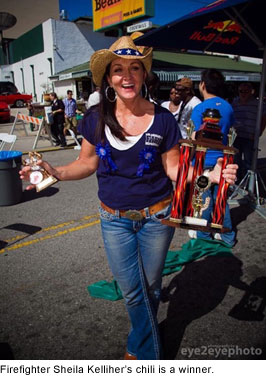 When President Barack Obama lunched earlier this month at a fire station in Midtown Manhattan, he sat down to pasta in cream sauce and eggplant parmesan—traditional New York firehouse fare. Too bad for his waistline he didn’t roll West Coast-style with Sheila Kelliher and her fellow Los Angeles County firefighters.
When President Barack Obama lunched earlier this month at a fire station in Midtown Manhattan, he sat down to pasta in cream sauce and eggplant parmesan—traditional New York firehouse fare. Too bad for his waistline he didn’t roll West Coast-style with Sheila Kelliher and her fellow Los Angeles County firefighters.
“We do a lot of grilling,” says Kelliher, a firefighter-paramedic at West Hollywood’s Station 8, where the take on firehouse cuisine is a far cry from the carb-heavy comfort fests dished up at fire stations in other parts of the country.
“Chicken, fish, pita breads, salads. Eleven years ago, when I first came on the job, it was meat and potatoes, but now healthier food is the trend. At least it is here.”
Kelliher should know. Last month, her quietly healthy recipe for Texas chili won the Barney’s Beanery First Annual Five-Alarm Firefighter Chili Cook-Off, a region-wide contest launched by the restaurant in honor of its 90th anniversary.
The recipe—a secret concoction of grilled tri-tip, red sauce, “no extra fat and not too many black beans”—was so delicious, yet light, that, starting June 1, it will appear on the Barney’s Beanery menu. Proceeds will benefit the Alisa Ann Ruch Burn Foundation, a nonprofit for burn survivors.
“Her chili was just very flavorful, it wasn’t too heavy and it wasn’t overloaded,” says the restaurant’s regional manager A.J. Sacher in a description that firehouse food experts say could easily sum up the philosophy of Southern California firefighters.
“In Chicago, they’ll grind up four pounds of meat and put in some macaroni and call it dinner,” says Jeff Gatesman, the West Los Angeles producer of “Feeding the Fire,” a web-based TV cooking show featuring firefighter chefs from across the country.
“But it’s a whole different story in California. We just shot an episode in Santa Monica and the guy made, like, pan-seared sea bass.”
Firehouse cooking is a venerable institution, particularly in cities where firefighters bunk in the fire station for 24-hour shifts that last several days.
“They work together, they sleep together and they break bread together,” says R.G. “Bob” Adams, author of “Firehouse Cooking: Food From America’s Bravest,” an international compilation of firefighter recipes that he says has sold more than a million copies since its first publication in 1993.
“The chef in a firehouse is the hub,” says Adams. “Kind of like the mother in a family.”
And like mothers everywhere, firehouse chefs are stewards of a community’s priorities and sub-cultures, from ethnic traditions to attitudes about nutrition and weight.
Long Beach Fire Capt. Eddie Sell, who is developing a cooking show for television called “Firehouse Chefs,” says that because firefighters have increasingly reflected the diversity of cities, firehouse meals “open the door to a city’s customs, so that when we have to make emergency calls to peoples’ homes, things aren’t as foreign.”
Where an East Coast firehouse might specialize in Italian feasts and a Southern company might be famed for rich desserts and gumbos, Sell says, West Coast stations will line up for pho and fish tacos.
“And definitely, there’s more heart-healthy stuff on the West Coast,” adds Matt Jackson, a West Covina firefighter-paramedic whose year-old Company Chow blog has become a recipe clearinghouse for firefighters from New York to Hawaii.
“Some crews I’ve worked on, the guys will have, like, gluten-free diets, or they’re not eating any simple sugars. Last year, ‘Live! With Regis and Kelly’ had a firefighter barbecue cook-off, and the California firefighter’s entry was actually a salad with barbecued pears.”
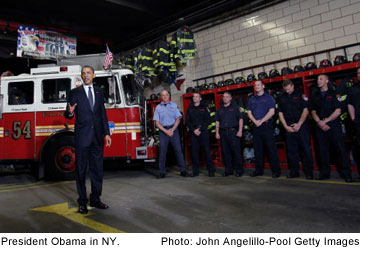 Kelliher, a Woodland Hills mother of 8-month old twins who does competitive bodybuilding in her spare time, says health is a priority at her station. (Check out one of her recipes here.)
Kelliher, a Woodland Hills mother of 8-month old twins who does competitive bodybuilding in her spare time, says health is a priority at her station. (Check out one of her recipes here.)
“Our county leads the charge when it comes to fitness,” she says. “We have a program called Fitness for Life. We have to pass a physical every year and meet certain benchmarks.
“And L.A. life is all about healthy lifestyle—a lot of our guys surf and snowboard and go to the river. Colder parts of the world, you don’t to do those things year-round, you’re covered up, maybe you eat more comfort food. But here, you hit the beach, the shirts come off and vanity kicks in.”
The 13 firefighters on her shift take turns at kitchen duty, she says: “Everybody puts in their money for chow—$12 for two meals, $7 for one meal—then whoever is the cook takes the money and goes to the store.”
All firehouse meals must meet two basic criteria, she says: “You can’t come up short, and it has to taste good.”
But health is a given, even for the younger firefighters who can eat as much bread as they want to. Grilling—which allows the fat to drip away from fish or meat during cooking—is such an art form at Station 8 that a few years ago, the whole crew chipped in and built an outdoor barbecue and grill station. “Everybody has their own specialty,” she says.
As for that special chili, she entered it in the contest at the behest of a friend, who knew it as something that Kelliher, who grew up in a family of Texas restaurateurs, served at Superbowl parties. Kelliher did her cooking off-duty and pressed her husband into helping her to serve massive quantities of the chili during the competition. It’ll be on the menu till September at all five of Barney’s Beanery locations in Los Angeles County.
Which may be the only chance her fellow crew members get to taste it. Ironically, she’s never served it at the firehouse. “It’s too labor intensive,” she said.
Posted 5/17/11
Trailblazer makes his mark in Calabasas
March 31, 2011
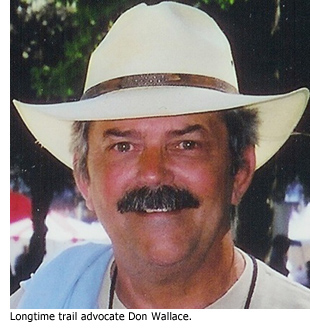 March was a banner month for Don Wallace. And not just because he and his wife, Jeanne, celebrated their 50th wedding anniversary.
March was a banner month for Don Wallace. And not just because he and his wife, Jeanne, celebrated their 50th wedding anniversary.
“We finished the party,” Wallace remembers, “and the very next afternoon, the phone rang.” With friends and family still filtering in and out of the Wallaces’ 4.5-acre ranchette in the Santa Monica Mountains, the longtime trail advocate let out a whoop as he received news for which he had waited most of his 70-year lifetime:
His beloved Las Virgenes Creek Trail had finally found its way under the Ventura Freeway.
“I was ecstatic,” Wallace says, still thrilled at the approval earlier this month of $300,000 in excess county bond funds that will allow the trail to run uninterrupted from the Santa Monica Mountains down through underpasses at the 101 and Agoura Road in Calabasas and on into Malibu Creek State Park.
The trail easement and improvements—officially dubbed “The Don Wallace Trail Project”—will not only connect the Santa Monica Mountains to the beach for people, horses and wildlife, but also honor one of the most zealous and hardworking trail advocates in Southern California.
For decades, Wallace and other activists have sought to create a path that would allow people and animals to follow Las Virgenes Creek from the pristine mountains down to the ocean, but their dream was stymied by development and traffic. Even as crucial tracts were acquired for the public, the 101 Freeway remained a dangerous concrete barrier between the mountain part of the trail and the beach part.
Then, last year, with funding allocated by Supervisor Zev Yaroslavsky, the Mountains Recreation and Conservation Authority bought a key swath of wilderness known as Firehouse Hill from the developer Fred Sands. The nearly 200-acre Calabasas property is a gateway to the Santa Monica Mountains National Recreation Area—and sits right next to the freeway.
Though environmentalists, activists and government officials cheered the acquisition for many reasons, trail advocates immediately saw its potential as an avenue through which they could bring the Las Virgenes Creek Trail—which is part of a larger loop called the Calabasas Cold Creek Trail—down to and under the 101 along a flood control easement, where it could then connect to the Malibu Creek State Park trail system. They’d just need to make the underpass safe and accessible.
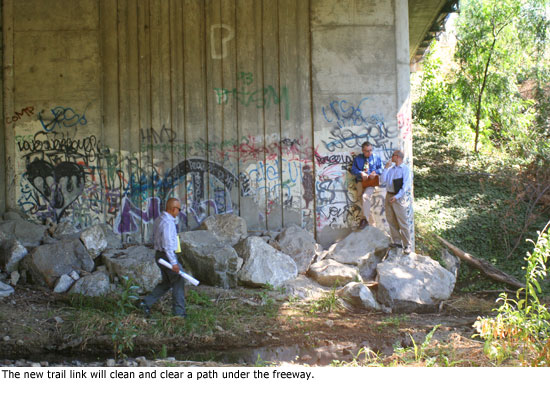
The March vote provided that crucial support, opening the way for a 2,500-foot link that is expected to break ground next year.
“This is a wonderful victory,” said Wallace, crediting the many public agencies that pushed for the project. But Wallace’s friends and fellow advocates say there’s a reason the key link is being named after him.
“He’s one of the hardest working gentlemen I know,” says Stephanie Abronson, who edits the newsletter for Equestrian Trails Inc., Corral 36, a mountain equestrian group.
Born in Tennessee , Wallace moved to Van Nuys as a teenager after his father, a restaurant owner, visited relatives here and made it a goal to move to California . At 20, he married Jeanne, whom he’d met in a chemistry lab at Pierce College .
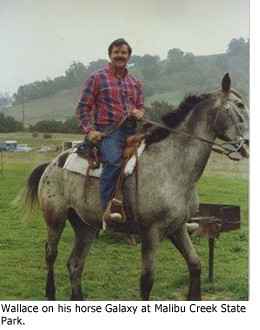 The couple settled in Canoga Park , had two sons and got into horseback riding, eventually deciding that they wanted enough land to have their own corral. Wallace, by now a Los Angeles city firefighter, found a spread near the unincorporated community of Monte Nido, and the couple built a house on it. They still live there with assorted horses, cats and dogs and a potbellied pig.
The couple settled in Canoga Park , had two sons and got into horseback riding, eventually deciding that they wanted enough land to have their own corral. Wallace, by now a Los Angeles city firefighter, found a spread near the unincorporated community of Monte Nido, and the couple built a house on it. They still live there with assorted horses, cats and dogs and a potbellied pig.
A trail ran near the Wallace’s acreage, and one day in the early 1970s, he says, a neighbor who wanted to build a winery came out with a bulldozer and blocked it in an attempt to keep passersby away.
“That trail had been put in in 1935 by the Boy Scouts,” says Wallace, who eventually forced the neighbor to open an alternative easement.
“It took three years of work and masses of paper, but I learned never to give up and never to say that it can’t be done.”
Since then, Wallace has served on the Santa Monica National Recreation Area Advisory Commission, the Resources Conservation District of the Santa Monica Mountains, the Malibu Creek Watershed Council and many other groups seeking to improve the mountains community.
He also served as a deputy for then-Supervisor Edmund D. Edelman in the early 1990s, and ran for supervisor himself in 1988 and 1994.
Throughout, when he wasn’t lobbying for trails or riding his horses on them, he was out clearing them with his bare hands, says Ruth Gerson, president of the Santa Monica Mountains Trail Council—“repairing tread, cutting back brush, reducing erosion, and encouraging others to work with him.”
That commitment has been challenged in recent years by health problems. Wallace says he has faced a stroke, vascular surgery and two bouts of prostate cancer since the 1990s; last year he underwent a triple bypass.
But his projects are far from finished—he’s already wondering how to restore the old Boy Scout trail behind his house.
“I walk every day,” says the trail blazer. “And I’m a very strong guy for 70.”
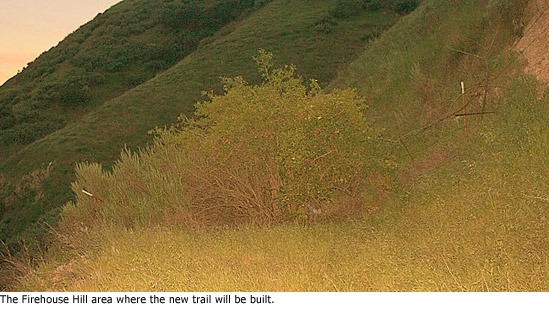
Posted 3/31/11
Seven tips for safe and sound holidays
December 15, 2010
This time of year can be such a mixed bag, and not just for Santa. There are great parties all over town—but has the guy in the next lane had a few too many? Is that glittering Christmas tree a tinderbox waiting to happen? And how’s the pet of the house expected to know that chocolate and poinsettias can be hazardous to his health?
If all this is starting to sound more like a minefield than a holiday, relax. Los Angeles County’s resident experts are here to help.
Their tips will help you navigate the pitfalls of the season—from the basics (driving sober) to the more arcane (making sure you’re not overcharged at the cash register.) They’ll even help you score a free bus ride on New Year’s Eve.
1. Don’t drink and drive.
This is rule No. 1 for a reason. Sheriff’s officials implore you to do the right thing, which means not getting behind the wheel if you’ve been drinking. If you need any reminders of the possible consequences, Sgt. Joseph Jakl, supervisor of the sheriff’s Traffic Services Detail, thinks this YouTube video from the city of Santa Clarita sums it up nicely. So designate a driver, call a cab or use public transportation if you choose to imbibe. (To make things easier, all Metro trains and buses are free on Christmas Eve and New Year’s Eve starting at 9 p.m.)
2. How to spot a drunk driver.
Jakl says to watch out for vehicles making overly wide turns, straddling the lane line, swerving, and randomly speeding up or slowing down. If you see someone who appears intoxicated and whose driving is endangering others, get the license number if you can do so safely and call 911 or your local police agency. The sheriff’s department and other law enforcement agencies also are planning DUI checkpoints across the county, through the holiday season and beyond.
If you have pets—or are planning on getting one at a “Happy Pawlidays” adoption on Saturday, Dec. 18–be aware that many of the hallmarks of the season, from shiny ornaments and treated Christmas tree water to candies and seasonal plants can be dangerous to animals. “While we are caught up in the hustle and bustle of the season, we may overlook some of the pet safety hazards,” says Evelina Villa, a spokeswoman for the Animal Care & Control department. A full list of the department’s holiday pet safety tips is here.
4. Practice safe shopping.
If you shop online, don’t tempt thieves by letting deliveries stack up on your front porch, says Lt. Scott Chew of the Malibu/Lost Hills sheriff’s station. Instead, he suggests having your packages delivered to your work address or to a neighbor who’s going to be at home during the day. Chew says it’s also common for people to leave expensive items like iPads and purses in their cars—an invitation to criminals year-round but particularly now. “Unfortunately, this time of year, there are people in the parking lots who are watching you,” Chew says. More tips, courtesy of the Santa Clarita Valley sheriff’s station, are here.
5. Check your receipt.
The Department of Weights and Measures wants to remind you to make sure that the amount you pay at the cash register matches the posted or advertised price. “Routine inspections reveal that overcharge errors do occur and often involve items with special promotional offers, ‘sales,’ and markdowns for which price information has not been updated in the scanner system,” the department said in a news release. “Holiday shopping presents many opportunities for such errors.” Here’s how to report an overcharge. And for a video report on the subject, check out this from the L.A. County Channel.
6. Scam artists don’t take the holidays off.
Bogus phone solicitations often crop up at this time of year, like this reported “green toilet scam” in Calabasas. And some would-be bargain hunters recently were victimized after setting out to meet someone advertising an “incredible price” for a camera on Craigslist. Instead, suspects in ski masks blocked their car and robbed them. Authorities advise skepticism and caution.
7. Keep the wrapping paper out of the fireplace.
County fire officials have put together this holiday tip sheet with advice on choosing, decorating and maintaining an indoor Christmas tree. They also say you should never burn wrapping paper in the fireplace; doing so “can produce dangerous sparks and a chemical buildup in the home that could cause an explosion.” Finally, they suggest getting an early jump on those New Year’s resolutions by making sure all of your smoke detectors are in good working order. Cheers!
Posted 12/15/10
Making a move on homeless at the Bowl
November 11, 2010
 Living in the hillside houses and condos above the Hollywood Bowl has long offered a taste of the rustic in the midst of the bustling city. For years, it’s also brought with it a stark urban reality: sharing the neighborhood with an encampment of homeless people.
Living in the hillside houses and condos above the Hollywood Bowl has long offered a taste of the rustic in the midst of the bustling city. For years, it’s also brought with it a stark urban reality: sharing the neighborhood with an encampment of homeless people.
Residents had long complained about crime problems and fire hazards associated with the impoverished community. “I know one of them came and jumped in our hot tub once,” said condo-dweller Jerry Shandy.
The Sheriff’s Department, which last year assumed policing responsibilities from county’s the Office of Public Safety, recently had its Parks Bureau set up shop at the county-owned Bowl, with a mandate to resolve the situation in a way that would help the homeowners as well as the homeless.
Sheriff’s Capt. Stephen Smith called in the department’s special problems team, which confronts crime and quality of life concerns in and around county parks. In addition to figuring out the logistics of shutting down the camp, the team created a plan to provide food, clothing and offers of shelter for the displaced.
 Deputy Jason Elkins, a 10-year sheriff’s veteran, twice walked the hillside and notified the homeless that, in the coming weeks, the area would be cleared. The Mountains Recreation and Conservation Authority, which manages the public land where the homeless had taken up residence, was brought on board, along with the county Department of Mental Health, Caltrans, the CHP, the Los Angeles City Fire Department and the nonprofit organization PATH (People Assisting the Homeless), among others.
Deputy Jason Elkins, a 10-year sheriff’s veteran, twice walked the hillside and notified the homeless that, in the coming weeks, the area would be cleared. The Mountains Recreation and Conservation Authority, which manages the public land where the homeless had taken up residence, was brought on board, along with the county Department of Mental Health, Caltrans, the CHP, the Los Angeles City Fire Department and the nonprofit organization PATH (People Assisting the Homeless), among others.
The effort was given a name that stressed its mission: “Hollywood Bowl Homeless Outreach Project”
“We didn’t want to leave anyone displaced,” Elkins said.
The operation began on October 27, with the team making its way up hillsides so steep that the homeless had created rope pulls to make the climb easier. Authorities had expected to encounter 30 homeless people but found that many, including one who’d been there for a decade, had left as a likely result of the notifications.
 Of the 14 who remained, ten accepted emergency shelter and the others voluntarily left, sheriff’s officials said.
Of the 14 who remained, ten accepted emergency shelter and the others voluntarily left, sheriff’s officials said.
Caltrans workers filled four trucks with the remains of the dismantled campsites. Follow-up work to remove overgrown vegetation took place Wednesday.
“From our perspective, unfortunately, we have to deal with these kinds of things quite a bit,” said Dash Stolarz of the Mountains Recreation and Conservation Authority, which now is working to restore the property and prevent new encampments. “It’s just a constant battle to make sure the parklands are safe.”
On Tuesday, Elkins and another team member, Deputy Nisha Sehdev, went back through the neighborhood Tuesday, talking to appreciative residents about the operation. One of them, Jack Calnan, spoke for the many when he said, “We really appreciate you being on top of it.”
Magnificent milestone in the mountains
June 9, 2010
Chalk up another win for the green team. After years of fending off development that could have overwhelmed its oak-studded slopes with condos, shopping centers or a massive megaplex, a spectacular swath of the Santa Monica Mountains can finally rest easy.
It’s now public land—to be preserved for posterity in its natural state.
The $6.25 million acquisition caps more than a decade of efforts by a coalition of government officials, environmentalists and activists seeking to preserve the nearly 200-acre property as an important wildlife corridor and plant habitat.
But the significance of the land—a rustic spread that once belonged to entertainment legend Bob Hope—goes well beyond its environmental value.
It also serves as an unofficial gateway to the Santa Monica Mountains National Recreation Area, visible to the 184,000 motorists who pass each day on the 101 Freeway as a symbol of the wilderness that still exists at the city’s edge.
“It’s just so special,” said Los Angeles real estate legend Fred Sands, who recently agreed to sell the property to the Mountains Recreation and Conservation Authority. “I’ve walked that property and I’ve hiked it. I’ve taken people there and their jaws dropped.”
Sands, who now is involved with commercial real estate ventures involving shopping centers and malls and also has a private equity firm, said he had considered building a horse ranch for his daughter on the property. He also mulled building a shopping center or keeping the land in a family trust and eventually constructing houses there.
He said the time he’d spent on the property changed his mind. “It’s the right thing to do,” he said. “The more I thought about it, the more I thought it shouldn’t be developed. This is just too beautiful.”
He said he’d considered hanging onto the property because it was worth more than he was being paid. But, he said, “I’m not exactly penniless. Not everything has to be about money…There’s a tax advantage. But I don’t need it for the tax advantages.”
“It’s about doing something for the public, and for the future.”
It is ironic but also fitting that the purchase of that scenic expanse is being bankrolled by, well, garbage. Specifically, the land was purchased, in part, with fees charged to hauling companies that use the Calabasas Landfill, along with money from a “gas-to-energy” program there.
 Now that it belongs to the Mountains Recreation and Conservation Authority—a partnership among the Santa Monica Mountains Conservancy, the Conejo Recreation and Park District and the Rancho Simi Recreation and Park District—the agency will maintain the rustic site and open it up to the public starting Saturday, when the property is set to be dedicated.
Now that it belongs to the Mountains Recreation and Conservation Authority—a partnership among the Santa Monica Mountains Conservancy, the Conejo Recreation and Park District and the Rancho Simi Recreation and Park District—the agency will maintain the rustic site and open it up to the public starting Saturday, when the property is set to be dedicated.
Dash Stolarz, a spokeswoman for the MRCA, said that crews were busily clearing brush from a ranch road that runs through the property. Parking is—and will remain—on a dirt lot. “We’re not going to develop it in any way,” she said.
Melanie Beck, an outdoor recreation planner for the National Parks Service, whose land borders the property, said the property will form an important link in the Las Virgenes Creek Trail, which is part of a larger loop called the Calabasas Cold Creek Trail. “I think it’s one of the most important acquisitions that the agencies have taken on in the last few years,” Beck said, noting the “visual relief” it provides for motorists leaving the San Fernando Valley.
Sands bought the property after the previous owner, Robert Zuckerman, was thwarted in his plans to build condominiums and a massive retail center on the land, complete with a 3,600-seat movie theater complex. Zuckerman’s proposal drew the ire of environmentalists and Supervisor Zev Yaroslavsky, and eventually fell apart after the county rejected his building plans.
Yaroslavsky said that Zuckerman had taken him on a tour of the property when he was seeking approval to build. “That was the biggest mistake he could have made,” Yaroslavsky said. “My first look at the dozens of mature oak trees and the pristine nature of the property convinced me on the spot that the property should be part of the Santa Monica Mountains park system.”
He said that after Sands bought the property, he inquired whether Yaroslavsky’s office would support any zoning changes to allow development on the land beyond the small number of homes that would have been permitted under current zoning. The answer was no.
Several years ago, Yaroslavsky approached Sands about selling the property to the MRCA. The agreement came together in the last 60 days.
The property is known to some as Firehouse Hill, a nod to the nearby Los Angeles County Fire Station 125. Others call it “Continental Communities”—a reference to Zuckerman’s ill-fated development plans.
Whatever you call it, the property ranks as the most significant acquisition since the former King Gillette Ranch, which the MRCA opened to the public in 2007. Since Yaroslavsky took office in 1994, almost 23,000 acres in the Santa Monica Mountains have been acquired and set aside as open space.
“We’ve saved a lot of big pieces, but it’s like pieces of a mosaic,” said Dave Brown, a community activist who’s been prominent in the efforts to preserve open space in the mountains. “You have to make sure there won’t be people coming in with inappropriate development plans.”
On the newly-acquired Calabasas property, that’s no longer an issue—to the relief of those, like Brown, who have worried about what might end up on this piece of land that exerts such a strong pull on those who’ve seen it.
“I’ve discovered over many years of living here that many people are emotionally attached to this property,” said Brown, who also is an appointee to the advisory committee of the Santa Monica Mountains Conservancy. “It tells people that they’re in a new area—an unspoiled natural area.”
Watch our video, “Santa Monica Mountains: An Island of Nature,” and read Zev’s blog about the remarkable strides that have taken place to preserve open space in the mountains.
Posted 6/9/2010
A different kind of biker bar—for a day
May 19, 2010
Last year’s Tour de France had Mont Ventoux. This year’s Amgen Tour of California has the Rock Store Climb.
Mont Ventoux is a diabolically difficult ascent in Provence, notorious among the world’s greatest bicyclists. The Rock Store climb is known among motorcyclists far and wide as 2.6 miles of Southern California two-lane nirvana.
Ventoux’s name has ancient origins but to the modern ear suggests the wind—vent, in French—that so often whips the summit. The Rock Store Climb’s name suggests, well, the Rock Store—a legendary Mulholland Highway watering hole that’s been a Hollywood hangout ever since Steve McQueen roared up one weekend day.
This Sunday, the Rock Store Climb will be on display for an audience more interested in Treks than Harleys. That’s when the tour—billed as the United States’ largest cycling event—takes a spin through the Santa Monica Mountains in the event’s final stage.
Make that four spins through the mountains.
Stage 8, described as the race’s “exclamation point,” is a 20.6-mile loop that will start at The Oaks shopping center in Thousand Oaks and will be repeated four times, for more than 80 miles in all, before it ends in front of the Westlake Hyatt. A more detailed interactive map is here.
Along the way, it will race along the switchbacks of Mulholland Highway and pass local landmarks such as Malibu Family Wines and the Rock Store. The winery will be hosting two events this weekend—a “Taste of the Tour” on Saturday afternoon and “Race Day at The Ranch” on Sunday. (Details on both events, along with information on other festivities in the area, are here.) At the Rock Store, at the base of the Rock Store Climb, owners Ed and Vern Savko will be serving a big private lunch on Sunday but plan to be open to the general public as well.
The Savkos’ establishment is off the beaten track. But it’s far from under the radar. This is a biker bar with a Facebook page. It also got some ink in a recent Wall Street Journal feature about scenic drives that car companies use to show off their new vehicles to the motoring press and has been the subject of coverage by motorcycle magazines around the world.
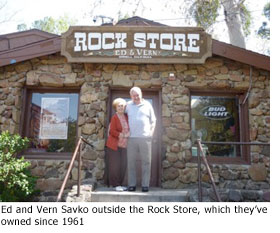 “This place is more known in Europe than it is around here,” says Savko, 84. “We get so many people, honey, you can’t even count ‘em.”
“This place is more known in Europe than it is around here,” says Savko, 84. “We get so many people, honey, you can’t even count ‘em.”
The Mulholland Highway stretch known as Rock Store Climb—or “King of the Mountain,” as Los Angeles County Sheriff’s Sgt. Philip Brooks calls it—is likely to be one of the most popular viewing spots during the race, with tens of thousands of spectators expected to line the winding route, which has an average grade of 7%. There’ll also be tented corporate events at the overlooks along the climb.
“We expect there’ll be wall-to-wall people there Sunday,” says Brooks, incident commander for the event, noting that the fire department will have a heli-pad nearby, just in case anyone gets hurt and needs helicopter transport.
Overall, spectator estimates for Stage 8 range from 150,000 to 250,000—with the biggest crowds expected at the race’s beginning and ending points, along with Rock Store Climb. “We’re set to handle whoever comes,” Brooks says.
Large crowds are also expected in downtown Los Angeles on Saturday, when the tour’s Stage 7 whirls into town. Metro’s blog The Source lists some viewing “hot spots” near public transportation and has the rundown on the 57 bus lines that will have detours starting at 5 a.m. on Saturday.
The tour, owned by L.A.-based AEG and sponsored by the biotech firm Amgen, which is headquartered in Thousand Oaks, started in 2006. But this is the first time it’s come through downtown Los Angeles—or this stretch of the Santa Monica Mountains. A coalition of three cities—Thousand Oaks, Westlake Village and Agoura Hills—came together as “Conejo Valley” to co-sponsor the final stretch of the 800-plus mile race.
The cities are encouraging spectators to watch from the official viewing spots—although viewers will be allowed all along the course, as long as they can find a safe and legal place to park. Information on parking and shuttles is here; a rundown on road closures is here. And a promotional video offers a preview of the course.
Out at the Rock Store Climb on Mulholland, the usual weekend crowd of motorcyclists will give way to some of the world’s fastest cyclists, who started the race on May 16 in Nevada City. Lance Armstrong was among them until he crashed Thursday outside Visalia.
Ed Savko says the cycling superstar had come by his store about six months ago. “He was just riding through,” Savko says.
A long line of other luminaries got there before he did.
Arnold Schwarzenegger is a longtime customer (or was before he became governor, Savko says.) Other well-known patrons range from Harrison Ford to Pink.
“I don’t even know who the hell the new ones are,” Savko says. “All my waitresses know them, though.”
Jay Leno is a house favorite. “You know when he’s there; people will leave their breakfast on the tables,” Vern Savko says. “They all flock to him.”
Even those who haven’t been to the Rock House in person might recognize it from its film and TV appearances, including “Happy Days,” when, as Savko lore has it, a young Ron Howard got behind the wheel with disastrous results.
“The first time he ever drove a car,” Ed Savko says, “he drove right into one of our gas pumps.”
The Savkos bought the place in 1961. “At the start, I was scared to take my own family because of all the tough guys,” Ed Savko says.
Not today.
“Mother’s Day, we were loaded with mothers, families and kids,” Vern Savko says. The customers, she says, “all call us Mom and Pop.”
And on Sunday, at least some of the passing racers will be calling out for mercy as they pass the Savkos’ place and head for Rock Store Climb—not once but four times.
“It’s going to be a tough ride for those cyclists,” Sgt. Brooks says.
Posted 5-19-10
These streets weren’t made for truckin’
April 8, 2010
First came the rains. Then came the trucks, hundreds of them suddenly rumbling through a sleepy Sylmar neighborhood.
They arrived at a staggering clip of 250 an hour, hauling tons of dirt that had cascaded down hillsides scorched by the Station Fire and into rapidly filling debris basins. Bumper to bumper, the trucks inched through the residential streets and up a private road to an obscure L.A. County “sediment disposal site.”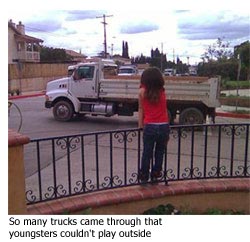
Then they headed back 20 miles across town for more loads—day after day, week after week, from 7 a.m. to 7 p.m.
The goal was to make sure no lives or homes were lost to mudslides that could result from overflowing debris basins in La Crescenta and La Canada Flintridge, the communities most impacted by last year’s blaze. But the problem was that residents of the Sylmar neighborhood were blindsided by the dump truck gridlock that hit their streets after the downpours of early February.
“All of a sudden there was a non-stop procession of dump trucks,” said Gigi Lewis, a 10-year resident of the neighborhood, near the 210 Freeway and Roxford Street. “We were literally imprisoned in our homes. We couldn’t let the kids ride bikes in the street or take our dogs for walks. I was in shock.”
Only in recent weeks have the window-rattling, teeth-gnashing convoys eased back. On Wednesday, for example, just 90 trucks were cycling between the sediment site and areas near the Station Fire’s enormous burn area.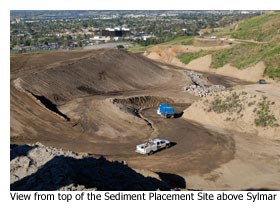
And more relief is on the way, thanks to a plan created by Supervisor Zev Yaroslavsky’s office and the Department of Public Works, which orchestrates the massive movement of earth from the county’s debris basins to its sediment sites (landfills, of sorts, for dirt).
This week, work began on a dirt road that will wind through vacant land mostly owned by the county and which skirts the small residential neighborhood. In a matter of days, all truck traffic will be routed along the new road, meaning peace (and quiet) is at hand for the community’s highly annoyed residents, many of whom say they were unaware that one of the county’s 25 active sediment placement sites was even on the hill above their streets.
Lewis, one of the highly annoyed, had a single word to describe the latest development: “Fabulous!”
The road’s completion also won’t come a day too soon for Paul Melillo, construction superintendent for the public works department. As the man responsible for the Sylmar site, he’s had an earful from residents. “They all know me,” he said with a hint of exasperation.
Melillo said he certainly empathizes with the homeowners who’ve endured weeks of noise, fumes and inconvenience. “I’d be upset, too,” he said. A 35-year veteran of public works, Melillo said he’s done his best to be visible to residents and responsive to their frustrations, while grappling with the fluidity and urgency of the operation.
“I tried to help in any way I could,” he said, “short of pulling the trucks off the street.”
Melillo recalled, for example, a woman who justifiably complained that she couldn’t get out of her garage in the morning because lines of trucks were always blocking her driveway. So, between 7 a.m. and 9 a.m., he positioned a worker near her house to cut a traffic break for her. “She was very appreciative,” Melillo said.
Public works department officials do acknowledge that they could have done a better job of letting the community know upfront what was headed their way—and why.
“The biggest lesson we learned was that we needed more effective communication with the residents,” said Bob Spencer, the department’s chief of public affairs. “This was a new situation for us. We were dealing with the worst fire in the county’s history.”
Spencer said the department was most focused on exploiting lulls between the storms to get debris basins in the burn areas quickly cleaned before more muck flowed into them. “In some instances, that had us working 24/7, with a fleet of more than 300 dump trucks. We recognized the pressure we were putting on the neighborhood but we needed to clean those basins to keep other lives and neighborhoods safe.”
Although the storm season has passed for now, the dangers—and the trucks—will likely be back for the next five years, according to Spencer. Each winter, debris will continue moving down the mountain into the basins until enough vegetation grows to help hold the soil in place.
Said Spencer: “We are definitely going to go through this exercise again.”
For Frequently Asked Questions (FAQs) about L.A. County sediment management, click here.
See what it was like at the traffic’s peak in February. Video Courtesy Gigi Lewis.
Posted 4-08-10
Shout it from the mountaintop—it’s Ballard Mountain!
November 1, 2009
Unexpected coalitions can move a mountain. Sometimes they can even change the mountain’s name.
That much was abundantly clear on a recent sunny Sunday morning at First A.M.E. church in Los Angeles, when an array of people from far-flung corners of Los Angeles assembled to pay tribute to a man, a mountain and a shared purpose that, improbably, had brought them all together.
There was a history professor, a geophysicist, a retired entertainment executive, a Los Angeles County supervisor and a retired city firefighter with much of his extended family in tow.
And there was the leadership and congregation of First A.M.E.—there to celebrate the journey that recently culminated in a new name for a prominent Santa Monica Mountains peak: Ballard Mountain.
Until this fall, it was called “Negrohead Mountain”—a ‘60s-era modification of its earlier name, which contained a racist slur.
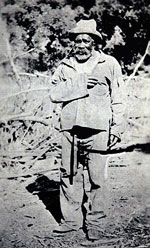
John Ballard
“Before it was Negrohead Mountain, it was another N-word Mountain,” Pastor John J. Hunter told the congregation, celebrating the fall of “another symbol of racism” and thanking Yaroslavsky for his leadership.
“Name the mountain for the man, not his race, and that’s what we’ve done,” Yaroslavsky said. “It’s the right thing to do and it’s a great thing to honor a man who’s been gone for almost 100 years.”
Kenneth W. Hudnut, a geophysicist with the U.S. Geological Survey, presented a map bearing the new name to Ballard’s great grandson, Reginald Ballard, Sr. The United States Board on Geographic Names made the change Sept. 9, at the request of the Los Angeles County Board of Supervisors, which adopted Yaroslavsky’s proposal to do so.
Reginald Ballard, 84, retired from the Los Angeles City Fire Department as a captain in 1978. In the mid-1950s, he had been part of a group of firefighters who challenged the department’s segregation practices, eventually prevailing and opening up promotional opportunities and integrating firehouses.
Although Reginald Ballard had been a part of history in that case, he didn’t know much about his own—until recently.
He said his father, Dr. Claudius Ballard, had been a good doctor but not much of a communicator. “I didn’t know anything about my family tree,” Ballard said. “We didn’t sit around the table discussing things.”
But, after reading an extensive article in the Los Angeles Times (here) that detailed the work of Moorpark College history professor Patty Colman on the Ballard family saga—and the efforts of neighbors who started the push to change the mountain’s name—Ballard and his grown children realized they might be looking at a long-lost link in their family history.
They connected with Colman and with neighbors Paul Culberg and Nick Noxon. Eventually, the connection to John Ballard was confirmed through marriage and death records.
Culberg, a retired entertainment executive who lives near Ballard Mountain, helped get the name change underway by telling Yaroslavsky about it at a holiday party last year. Culberg said he and his wife, Leah, were thrilled to have been part of the coalition that made it happen—and delighted to have been invited to First A.M.E.
As for Colman, “the biggest thrill of all for me was when we actually met the descendants. Sitting there chatting with Reginald Ballard, that’s the closest I’ll get to John Ballard.”
In addition to The Times, the story has been chronicled on television and newspapers from the Agoura Hills Acorn to the New Zealand Herald.
Ryan Ballard, Reginald Ballard Sr.’s youngest child and the great-great-grandson of John Ballard, took a special joy in bringing his wife, Nicole, and their two young sons to the service.
“As a father, it’s quite significant,” said Ballard, 37, a special education teacher at Locke High School. “You’re always thinking of what you’re going to leave to your kids. Who’d have thought that this would be left for them as part of their legacy?”
The family hasn’t hiked up to the Ballard Mountain—yet.
“You know the plan is already underway,” Ryan Ballard said.




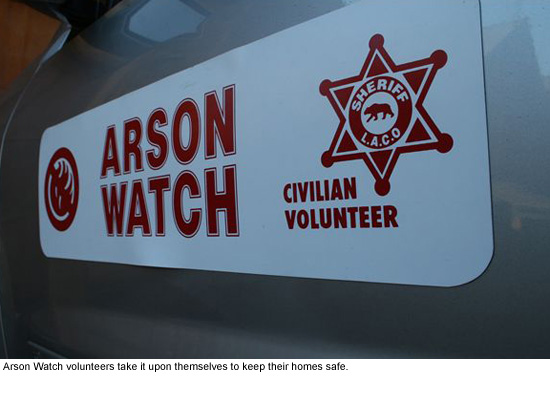
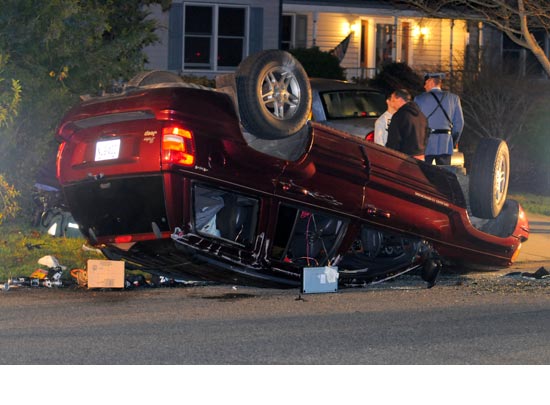

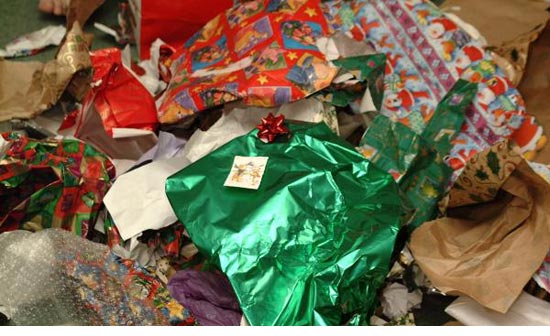
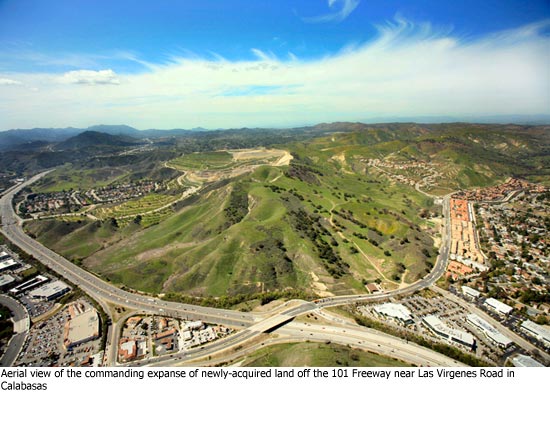
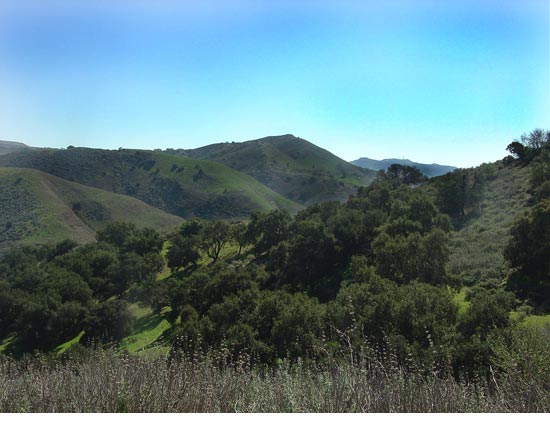
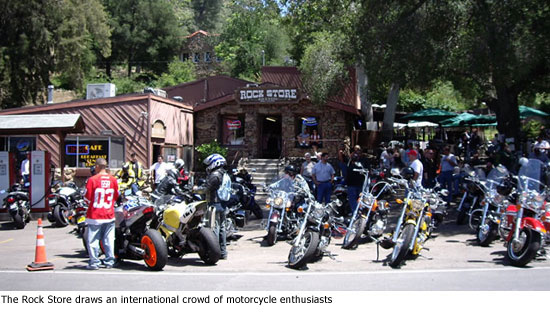

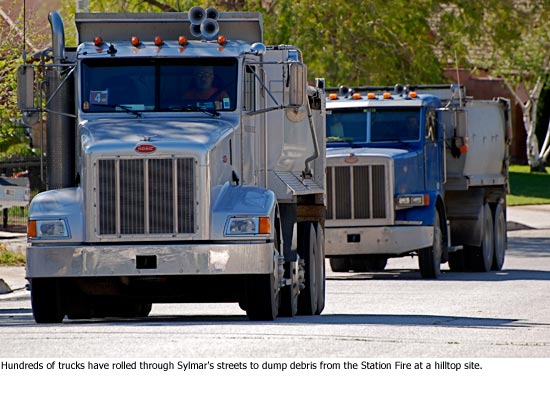
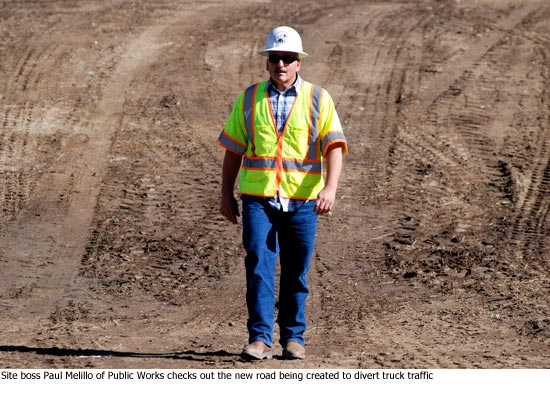
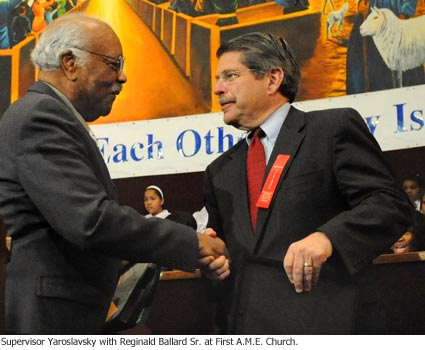







 405 bridge work causes a stink
405 bridge work causes a stink

